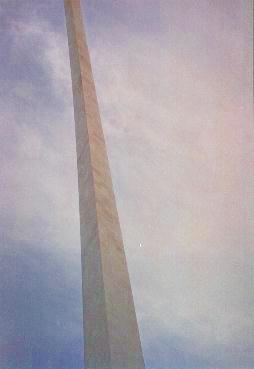
The prliminary design for the Arch called for guy cables at about the 530-ft. mark to stabilize the structure. Computations indicated that such stabilization would require one 6-in or two 3-in. cables on each leg--resulting inconsiderable cost as reuse of the cables would not be practicable. This, and some additional problems with the cables, led designers to the idea of using a stabilizing strut or truss at the 530-ft level.
When this level was reached, the two creeper derricks working together raised and positioned a steel stabilizing truss 255 ft. long, which connected the ends of the two legs and braced them against each other while the remaining sections were put in place to complete the arch.
The truss was 40 ft. wide, 15 ft. deep and weighed about 60 tons. It was connected to the Arch by means of steel harness fitted around each leg so that the loads due to the increased weight and wind force on each leg would be transferred directly to the foundations.
After the stabilizing truss was erected, 21 sections were add to each leg. The next step was to put the final "keystone" section into place to complete the Arch. A jacking frame was used to exert pressure against the two legs so that this section could be set in. With the arch completed, the stabilizing strut was lowered by the creeper derricks before they started their trip down the legs, dismantling and lowering their tracks as they progressed. At the same time the bolt holes in the stainless-steel surface were plungged and ground smooth.
|
